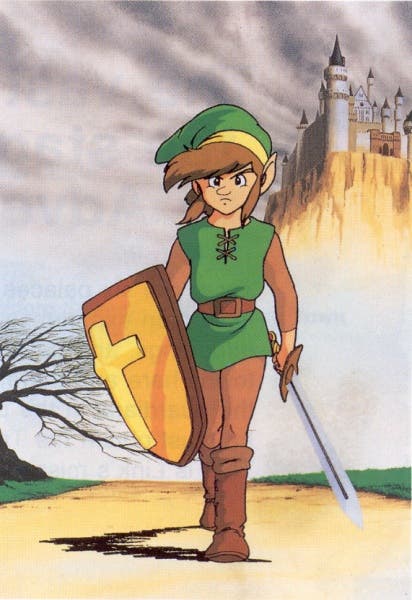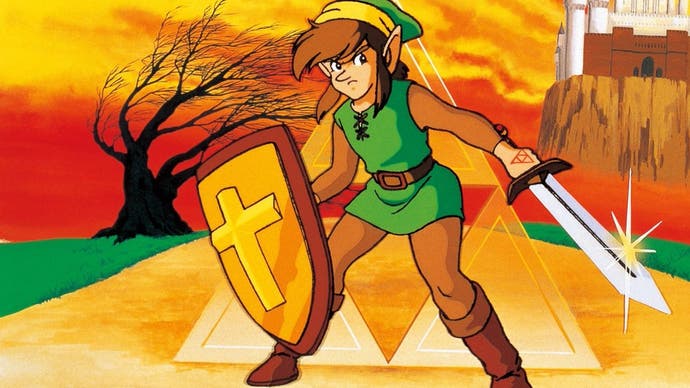Zelda 2 is great, and you should try it on the Switch
Missing Link.
This week, Nintendo is adding Zelda 2: The Adventure of Link to Nintendo Switch Online's digital NES library. But maybe you do not want to try Zelda 2: The Adventure of Link. You don't even want to give it a chance. Maybe you heard it's a "controversial" and "divisive" episode in The Legend of Zelda series, or maybe you heard how Miyamoto himself considers it his "bad game". But what you probably do not know is that Zelda 2 is great. It's flawed, it's different, but it's great. And it's very, very weird.
Zelda 2: The Adventure of Link has a top-down overworld where Link is shown with exaggerated proportions (at the time, Nintendo was probably influenced by Dragon Quest and Ultima). But it transitions to a side-scrolling action game with a dedicated jump button when you enter a town, a cave, a dungeon (here called "Palaces") or a random encounter with enemies - because Zelda 2 has something like random encounters. And it has RPG elements, too: it has levels, experience points and stats.

Doesn't sound very Zelda-ish, right? Well, defining a Zelda game is easy to do today. But at the time of Zelda 2's release there was not no easy answer, because there had been only one other episode. For example, the standard structure of The Legend of Zelda dungeons, where Link must acquire a main item to complete a puzzle-filled maze and defeat its boss, wasn't introduced till The Legend of Zelda: Link's Awakening (1993). And in more recent times, Breath of the Wild completely subverted what we would expect from a Zelda game, mixing puzzles and a sandbox, open-world exploration. Zelda 2 attempted to answer "What is a Zelda game?", and its answer wasn't puzzles, and it wasn't dungeons, though its answer was just as valid as any of those. Its answer was, quite simply, the journey of a hero into the unknown.
Zelda 2 is epic. Zelda 2 is epic because of its brutal swordplay and because of its soundtrack, composed by Akito Nakatsuka (Ice Climbers). But above all I think Zelda 2 is epic because it tells the struggle of a character who changes, grows and learns while venturing through a perilous quest.
In Zelda 2 you have no arrows or bombs, you do not find different swords and new shields. Most items give you passive skills: the Candle lights up caves, the Boots allow Link to walk on rivers and specific sea tiles, the Glove allows him to destroy blocks and so on. The Flute and the Hammer are the only Items that must be activated by the player, and they are used only a few times. Items are not as important as in the rest of the series: Link does find new tools, but above all he learns new spells and attacks and he levels up spending the experience points gained in battle. Zelda 2 is one of the few Zelda games where Link doesn't become stronger just by hoarding stuff.
Here, dungeons are small and do not feature maps and compasses, but they are still reminiscent of your standard Zelda dungeon: you walk in, you find keys and open locked doors to explore a non-linear underground space, you find the "dungeon item" and you defeat a boss. But like the original game, Zelda 2 really shines because of its overworld.

The first game is highly regarded because of its overworld: Link can explore most of the map from the very beginning. The upside is that players enjoy a greater freedom, but that also means they rarely find new places after the few first hours. Sometimes, the overworld is just the path from one dungeon to the next. Zelda 2, on the other hand, introduces towns with villagers and side-quests and unveils its map bit by bit. It feels more linear, but every step increases the size of the explorable map and brings Link to new places and new challenges that he has to overcome in order to enter the next Palace. When Link reaches the southernmost part of the map, he finds that he has returned to the area of the first game. He sees Death Mountain, the lake, the Lost Woods and the graveyard, but everything is so tiny now. The whole region of the original game is just a small corner of the map of Zelda 2: Link is older, the stakes are higher and the world is bigger. The Zelda series goes on try to replicate this sense of scale and paced discovery in following games, but it's Zelda 2 that introduced it.
And what about its difficulty? The first thing to do if you want to tackle Zelda 2 is read its manual. Nintendo isn't doing the greatest job in introducing a new audience to its NES games: the Nintendo Switch Online service has no links to the original manuals, nor are there simplified electronic manuals like the ones we were used to find on Virtual Console. But there is an official scan of the English manual of Zelda 2 and you can find it here. The manual covers everything you need to know about Zelda 2: its convoluted backstory (did you know princess Zelda in Zelda 2 is not the same princess Zelda of the original game, even though both games star the same Link?), its controls, its items and its areas, its monsters and its spells. The manual is the tutorial, so do not skip it. And then, accept the difficulty of Zelda 2 as part of its spirit: Link must suffer and learn to become better, and so must the player.
Zelda 2 is not perfect. Its bosses are usually just well armed anthropomorphic enemies, since the technology didn't allow Nintendo to put larger sprites in the cartridge. They're not very epic. But it was an innovative game - it influenced proto-Metroidvania works like Faxanadu and changed the overworld of The Legend of Zelda series. Beneath the surface, Zelda 2 manages to be something more than a prototype for a series still in development: it has its own vision. And you should most definitely play it.








